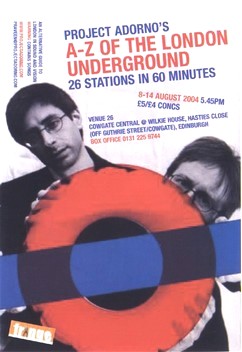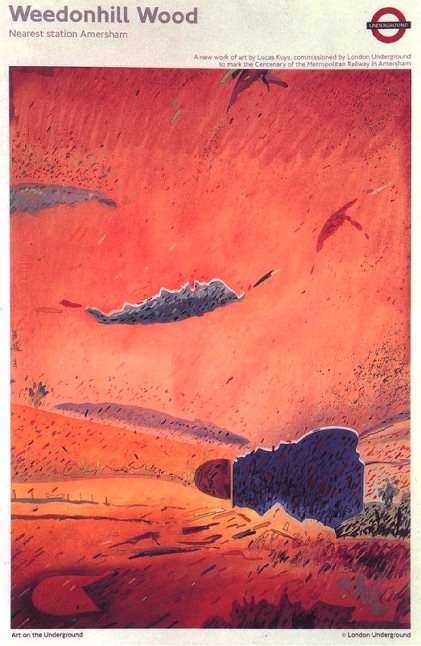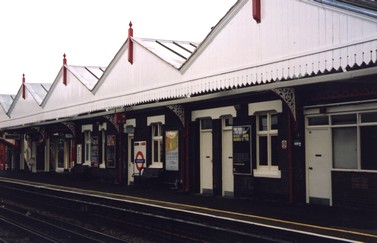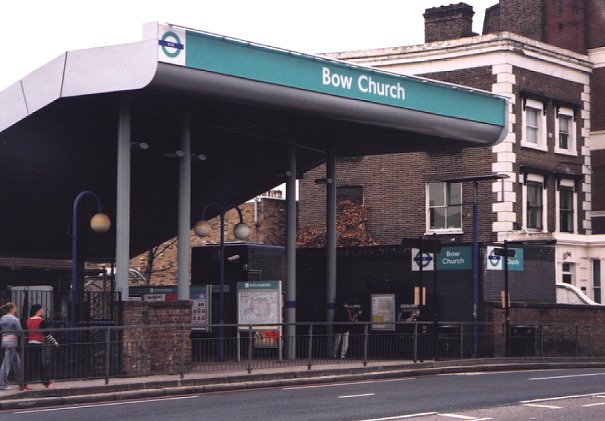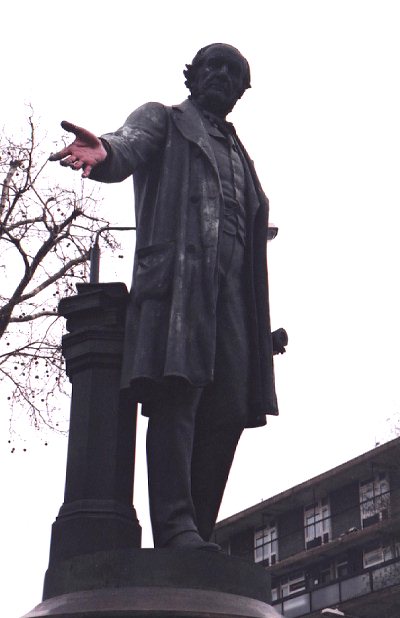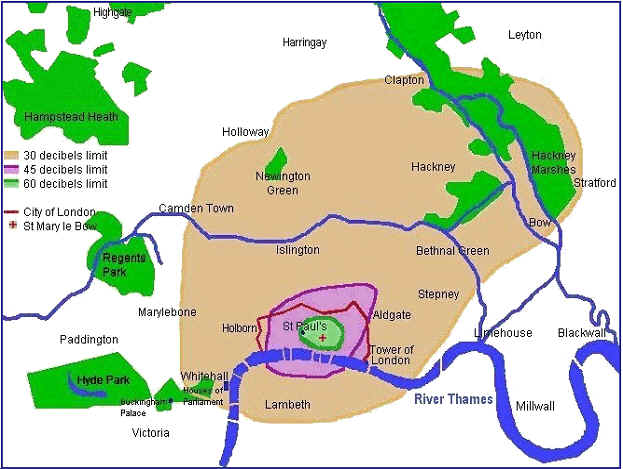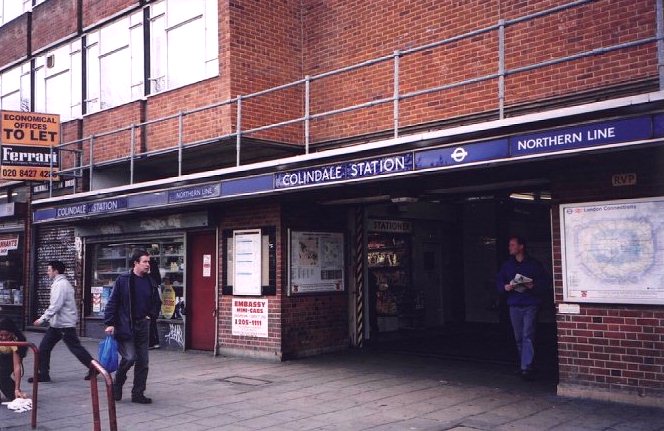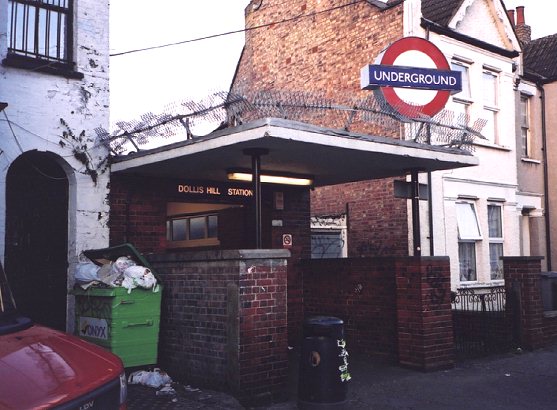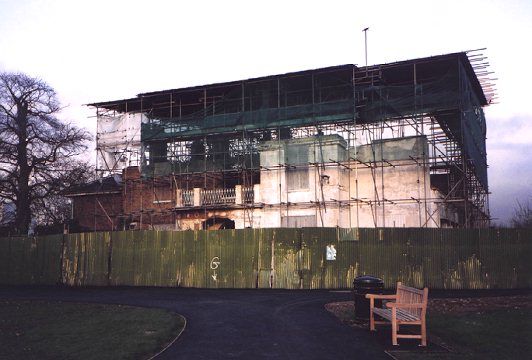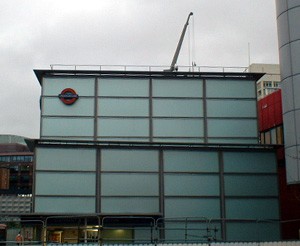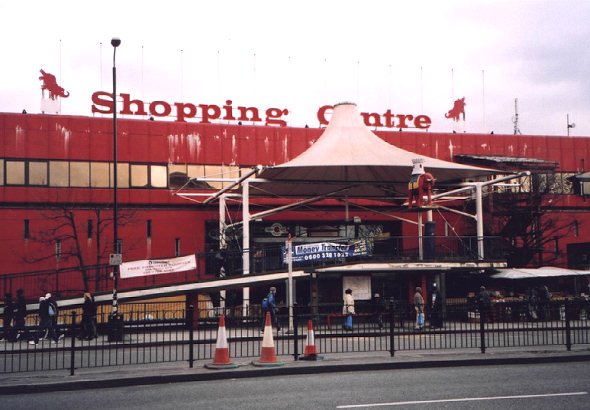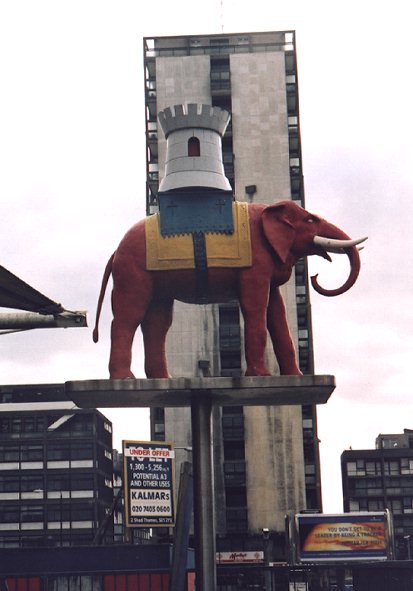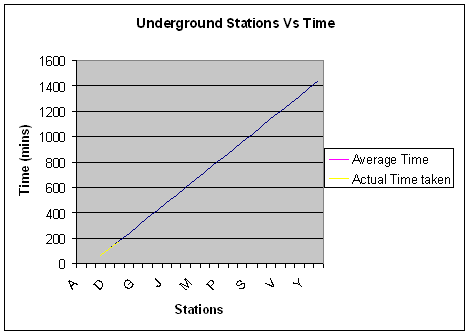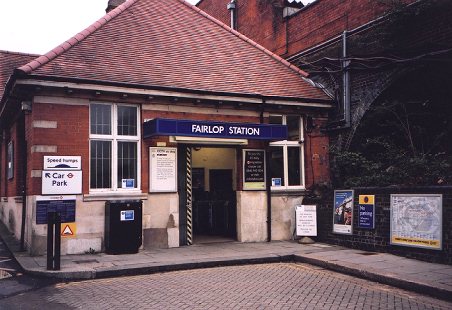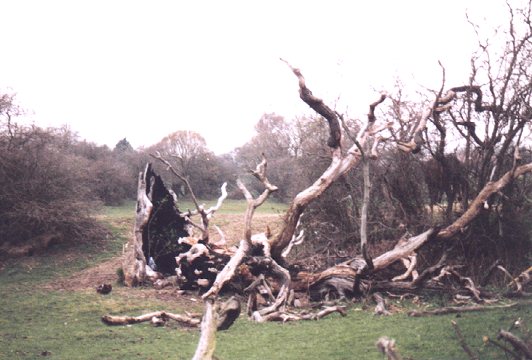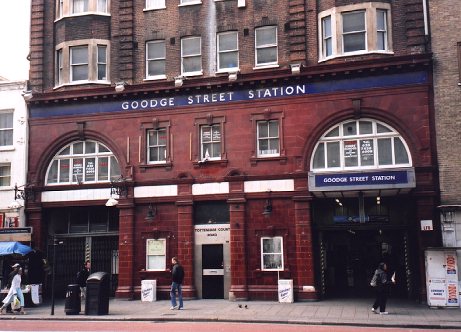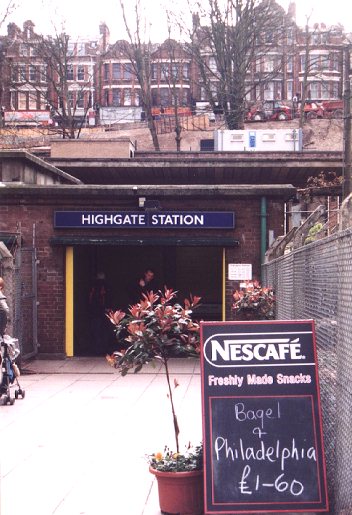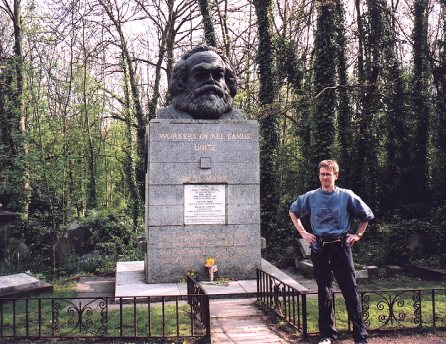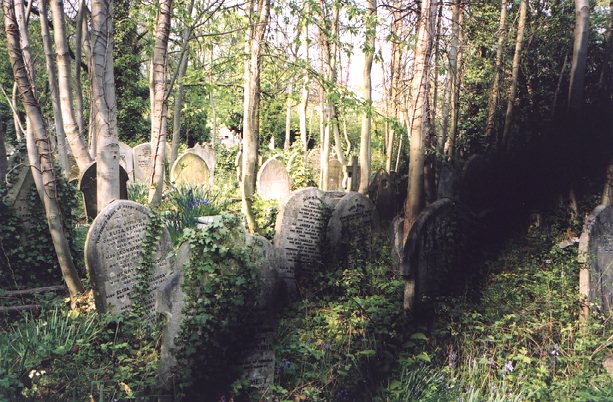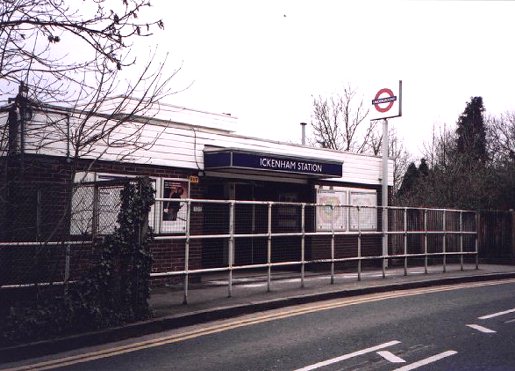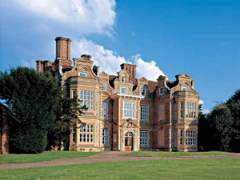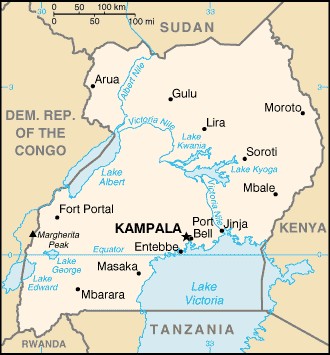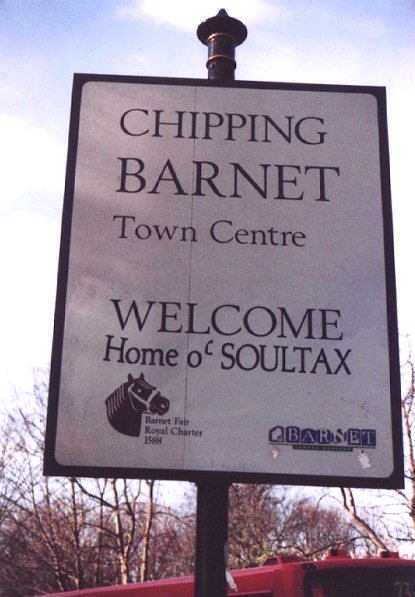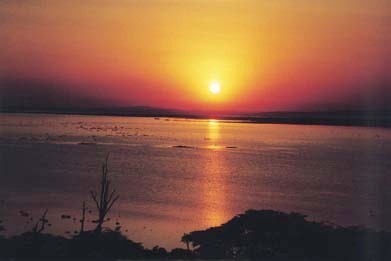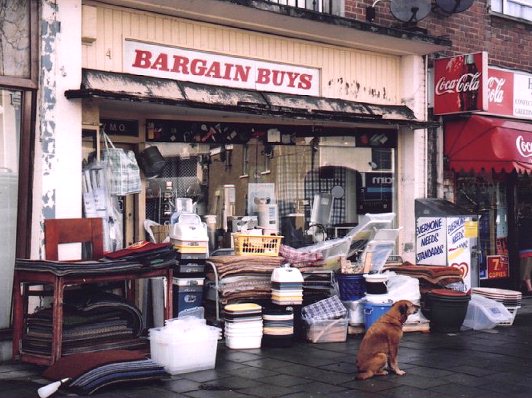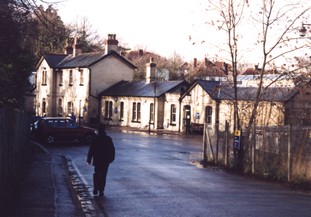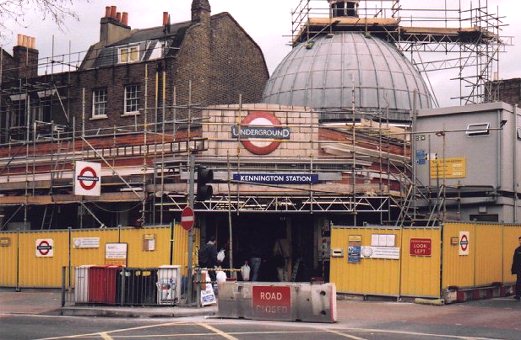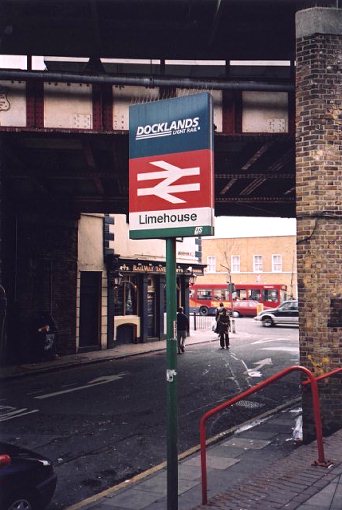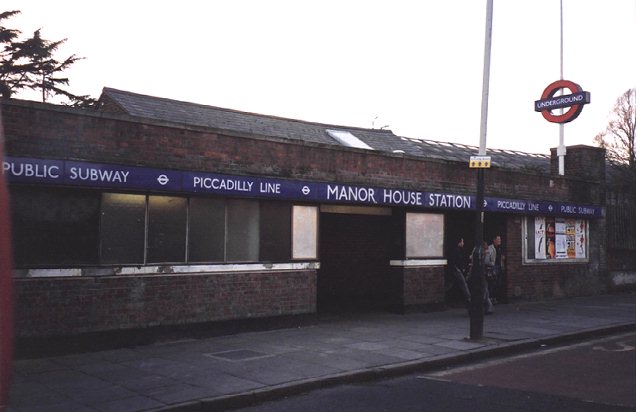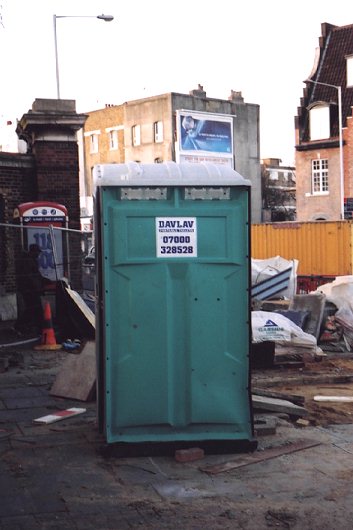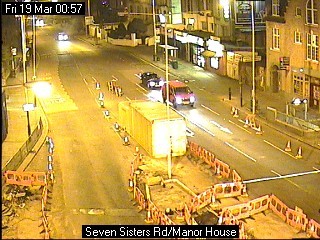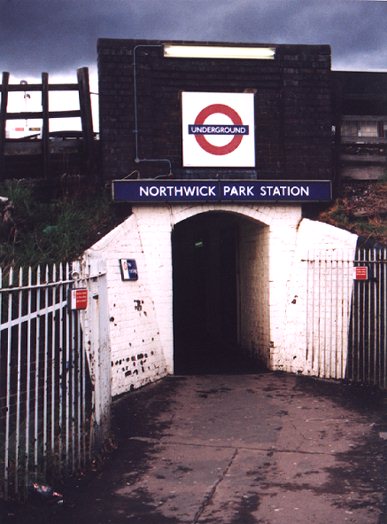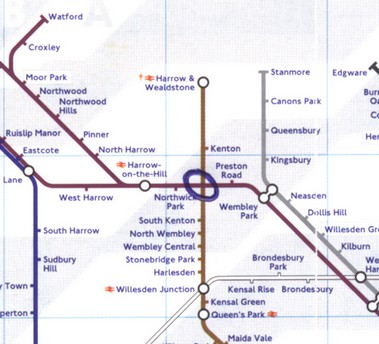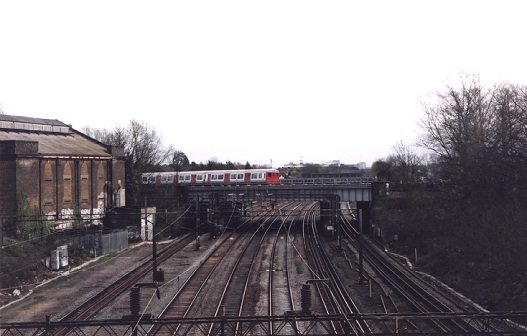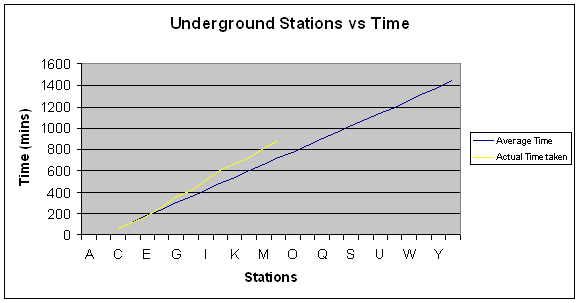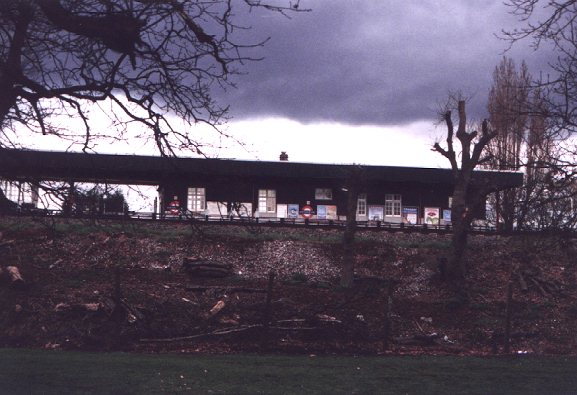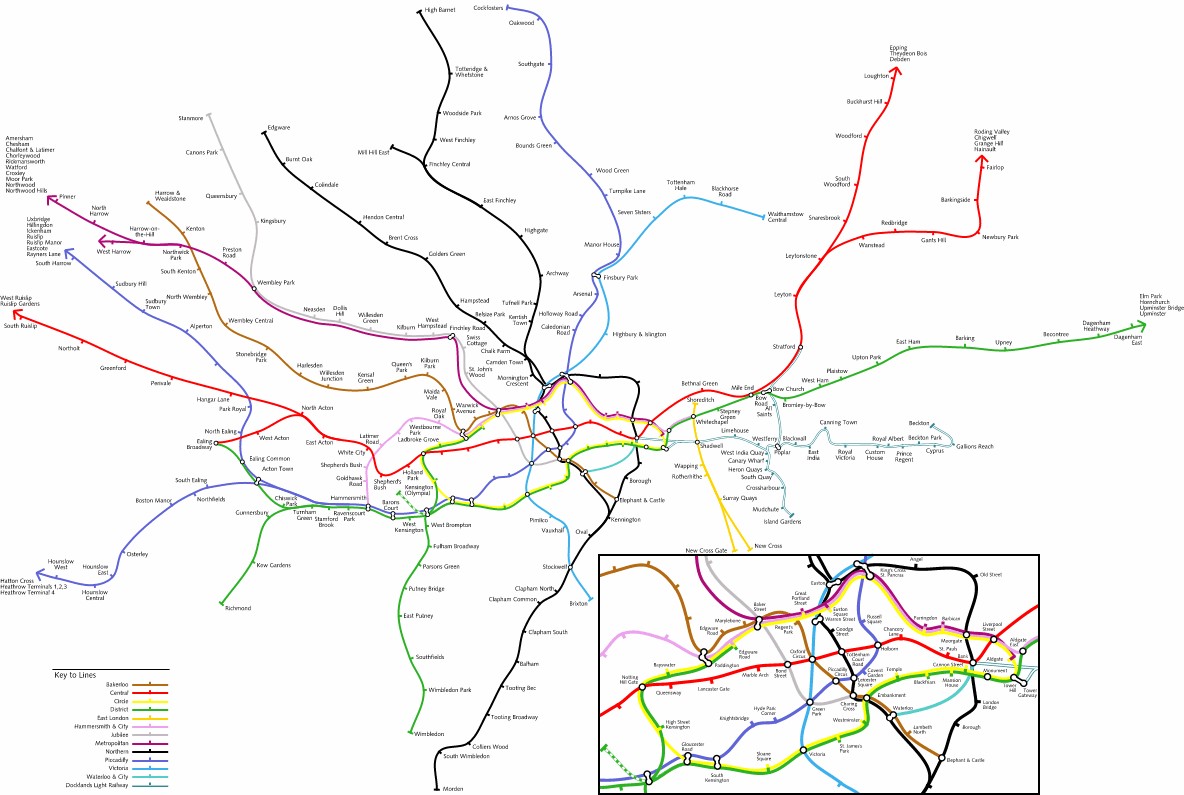| Information | In the news | In Record | In View | In Review | In Writing | In Performance | Interesting Others |
Project Adorno’s A-Z of the London
Underground | ||
|
The brief:
to visit 26 stations on the London Underground from A-Z, in a weekend, in
the process writing a song or poem inspired by each location, ultimately
creating an alternative cultural guide to underground London… The idea
became a reality and in turn became an Edinburgh Festival Fringe
Show. | ||
|
Day 1: Amersham | ||
|
Praveen: So… where is
it we’re going?
Mars or Weedonhill Wood?
London Underground poster I’d always had
this fascination with Amersham – up there on the outer most north-west
quadrant of the Metropolitan line. It seemed a romantic and exotic world –
whilst still, technically (at least by tube standards) being part of
London. I remembered seeing posters advertising Weedonhill Wood (at a time
when London Underground were trying to promote usage of the tube) –
Amersham being the nearest station. It wasn’t just the place that
intrigued me, it was also, I must confess, the wonderment of what the tube
station and all those in-between would look like. So, early one
Saturday morning we just decided to take off and go there – to see how the
Amersham of our imagination compared with real life and London as we knew
it… There was a community play on that day about the “Amersham martyrs” which we thought we’d go and see and whilst there, take in the town and/or whatever happened to be there….So already we were building up a picture – Weedonhill Wood – countrified, a community play being put on in a local church and also, talk of the Amersham museum (in the blurb about the play) – so a place full of culture and history. What’s more we’d be travelling up on the oldest section of the London Underground. In an effort to get out
of the rain we sought refuge in the nearest cafe we could find – we
figured there would be a proliferation of quaint tea shops or coffee
houses dotted around Amersham – in fact all we came across was a Wimpy
bar. Hmm….so much for culture
then. And what’s more, the
total population of Amersham appeared to visiting there at that particular
time. The rain stopped and we
worked out that we were in New Amersham (also known as Amersham on the
hill) – Old Amersham was where we needed to be for the
Amersham Martyrs play, so we set off down the hill. This was more like it
– apart from the big out-of town style Tescos, there was traditional high
street with old fashioned pubs, shops and the Amersham museum. Tescos
itself was in a bizarre location – not fifty yards from a small field
containing chickens and a pig! We found the picturesque church where the
play was being held and to our astonishment we learnt that that particular
day’s performance was totally sold out! We couldn’t believe it – a
community play in a church in far flung Amersham – sold out! “But we’ve
travelled all the way up from Morden” we pleaded…but to no avail.
Obviously not much in Amersham in the way of entertainment.
Amersham Station: very Camberwick Green We decided we’d had
enough of this place on the edge of the Chiltern Hills – we needed to get
back to the grime of the capital – we were real Londoners and this didn’t
feel like part of our city. Walking back to the station we began
wondering, if we had to choose, where would the real heart and soul of
London be? What part of London truly personifies the London-ness of
London? Looking at the tube map back at Amersham Station (looking more and
more to our eyes like a station out of popular children’s TV programme
Camberwick Green) we singled out Bow – yes! Bow Bells, cockneys etc –
surely a contender for the soul of London! Being in no particular hurry,
we decided to go straight there. Oh, and we never did find Weedonhill
Wood… Amersham - the songAs part of our brief we
decided to write a short song, poem or piece of prose about or inspired by
each place visited. The song for Amersham ended up being called “Amersham
Summer Holiday” – casting Amersham as a strange yet quaint, almost foreign
country within a country. In essence this is very much how it relates to
London – it is technically part of London (if we define all places covered
by the London underground as being in London, that is) and yet is so
“other” or Un-London-like. The rain during our visit adds an ironic twist
to notion of Amersham as a summer holiday location. Musically it harks
back to songs from children’s TV programmes such as Camberwick Green and
Play Away. Project Adorno go Derek Griffiths.
| ||
| Bow | ||
|
But what about actually
visiting the places themselves, getting out of the tube and feeling the
ambience, taking the cultural pulse, maybe finding out something of each
place visited? How long would this take? We started thinking, well
we’ve been to Amersham and now we’re going to Bow – by pure chance
visiting a station beginning with A followed by one beginning with B –
what if we continue the pattern? Being both reasonably competitive people
and up for a challenge (however, surreal), we came up with the following -
how about we attempt to visit 26 tube stations A-Z in alphabetical order,
taking back with us something that describes the essence of each place
we’ve visited. Maybe writing a poem or song or something to encapsulate
each one? Well, we were nearly at Bow – two down, 24 to go… Bow of course is famous
for the notion that anyone born within the sound of Bow bells is a true
cockney…..so it seemed to us a good idea to find these bells and if
possible, hear them in action and see if we could see any real-life
cockneys around.
Bow Church: the petrol station school of architecture There are two stations at
Bow – Bow Road (District line) and a few yards further on, Bow Church
(actually on the Docklands Light Railway). The church in question –
the Church of St Mary’s - stands in the middle of a large road junction –
we assumed this was our church – the church associated with the bow bells
cockney myth and also that alluded to in the story of Dick Whittington –
where the bells urge him to return to London. There was even a pub across
the road called “The Bow Bells”. No sound of any bells
however whilst we were there and nothing to indicate that this church had
any famous bells. The only thing of note, somewhat bizarrely, was a statue
of Gladstone “with blood on his hands” – quite literally, someone (we
suspect it was a politically enlightened student) had painted his hands
red – what heinous crimes had he been linked with?
Gladstone caught red-handed with his fingers in the till… However, it turned out
that this wasn’t after all the right church – the real “bow bells” had
originated from St Marys…..located in Cheapside – somewhere near St
Pauls.
This is stretching the “cockney myth” somewhat! It certainly seems strange
to consider that anyone born within the sound of bells located in the city
should be considered a cockney. Which brings us to
another altogether more serious and scientific conundrum – we’ll accept
that the “Bow bells” are in the city – however, just how far away would
one be able to hear them? Assuming they were ringing at the time of your
birth - How far away need one be born to still be considered a
cockney? An academic in trying to
work this out has come up with this rather useful map showing church bell
decibel levels:
Church bell decibel levels It would appear, with the
wind blowing the right direction, that cockneys can be created as far away
as Holloway in the north and Lambeth in the south… Bow - the song Somewhat inevitably this
quickly became a cheeky cockney knees-up documenting the fact that the Bow
Bells are really in St Pauls – this is in essence becomes it’s
punchline.
Stylistically think “Laughing Policeman” and Benny Hill and you’re not too
far off the mark. I think there’s a bit of Blur in there somewhere as
well… | ||
| Colindale | ||
|
It was still early on
Saturday, so, tube map in hand we closed our eyes and plunged a safety pin
in the vague direction of the list of stations beginning with “C”. We had
accepted the challenge and our next port of call would be Colindale. It was time to go back to the suburbs on that
old favourite of ours – the Northern line – this time going north and more
uncharted territory. We found ourselves
travelling along Edgware branch of the Northern line – this provided a
shock – just north of Hampstead the train emerged from the tunnel to go
above ground – this didn’t seem quite right somehow - apart from a short
stretch of track leading into Morden station we’d never travelled on the
Northern line in daylight before – it and its map colour coding being well
suited (black). (In fact the Northern line contains the longest continuous
tunnel on the network – running for 17.4 miles between Morden and East
Finchley (via Bank). Another useless fact to know is that only 42% of the
London Underground is actually “underground”).
Colindale station Truth to tell, Colindale
is almost as mundane as its name suggests. However it does have two small
yet distinguishing features. One is that it is home to the British library
newspaper archives. The other is evident from the train as you approach
the station – a huge Police training ground. Our interest was aroused when
we spotted a real bona-fide Tardis style police box. There wasn’t much
else to give it away – the training ground itself seemed to consist of
numerous football pitches with various football matches underway – so
that’s how the Police train? May explain a lot…. Upon arrival, we decided
to head for the police training ground, yet despite being so obvious from
the train window, we couldn’t find it anywhere. We decided to ask for
directions – and who better to ask than a policeman?! We found one
loitering nearby and asked him where we might find the training ground.
After giving us the most detailed set of instructions possible he then
added “You’re not terrorists, are you?” A bit late in the day if you ask
me…. In actual fact the
training ground was just round the corner and by this time our friendly
policeman had decided to direct us in person. Along the way we started
telling him about our recently devised “mission”. I think he thought we
were quite mad. He started telling us his life story. It turned out he was
a member of the “Specials” – that is, the Police “Special Forces” which
sounded quite exciting until he reeled off the sorts of things this
involved – marshalling at street parties, helping old ladies cross the
road, that sort of thing……..which sounded to our laymen ears at least, the
sort of things that “ordinary” police men and women do anyway in the
course of their daily duties. The police training ground looked more like
an enforced labour camp the closer we got to it complete with a huge steel
mesh fence and a security guard in a little hut reading a copy of the Sun.
We took a few photos from across the road thinking we’d be arrested at any
moment. We soon decided to high-tail it and head back to the tube – our
work in Colindale done. There was clearly nothing else here. Our policeman
said he would “accompany us to the station”. In order to keep things
on a “random” keel we asked him to choose our next station reminding him
that it must begin with “D” Thematically there were
two things going on here – on the one hand it’s list song namechecking
numerous fictional TV policemen and woman (Columbo, Cagney and Lacey etc)
with a chorus alluding to Jerry Dammers and his pop band the Specials.
Musically it’s a lo-fi Blur/Damon Albarn inspired piece with softly sung
vocals and cheap sounding acoustic guitar. We were quite pleased with
this, although when performed I’m not sure if the audience ever really
“got it”. Perhaps there is some confusion in the fact that it’s not really
inspired by Colindale the place. | ||
| Dollis Hill | ||
|
Mark
Twain famously said of the place that ‘Dollis Hill comes nearer to being a
paradise than any other home I ever occupied.’ We were looking forward to
it. Upon arrival at the station we wondered whether we’d got the right
place…
Dollis Hill: Nice wheelie bin We decided to seek out
Dollis Hill house, where Twain had stayed, and see whether this was a bit
closer to the “paradise” he mentioned. Looking at the
station’s “places of local interest” map we spotted Gladstone Park where
Dollis Hill House was supposedly located. This was interesting –
Gladstone, whom we’d seen “red-handed” in Bow was obviously big in this
part of the world also. It turned out that he’d also been a frequent
visitor to Dollis Hill House and now even had a park named after him. Somewhat aptly the park
was very hilly, Dollis Hill house being at its highest point. After a
steep climb there it was!
Dollis Hill House: No vacancies We were somewhat
disappointed. Surrounded by corrugated iron and scaffolding it certainly
wouldn’t be putting up any guests in this state.. We walked round and
round the perimeter but couldn’t find any actual reference to it being
called Dollis Hill House. There was an information board nearby and this
told us that the park and surrounding area were currently being
refurbished and modernised. No mention of what they planned to do with the
house though. Mark Twain must be turning in his grave…. Back at the station there
seemed to be a wealth of under-employed London Underground staff doing
very little at all and looking rather bored. In an effort to brighten up
their day, and in the spirit of our enforced randomness, we asked them to
choose our next destination point – the only criteria being that it had to
be a station beginning with “E”. They all looked rather non-plussed at our
request – certainly not the usual type of enquiry about where to get off
for Buckingham Palace or the like. Someone shouted out “Elephant and
Castle” and before any more names could be plucked from the world famous
tube map, we were through the barriers and on our way. Dollis Hill – the song One
of the more successful pieces during our Edinburgh run –in which we
imagine how Mark Twain’s novels would have turned out if he’d lived in
Dollis Hill….a fast-paced pontification on life in north west London,
complete with fake banjo, and including the memorable line “Huck’s hitched
a hammock ‘tween a pair of council wheelie bins”… | ||
| Elephant & Castle | ||
|
Elephant & Castle station: New Northern Line entrance This was more like it –
down south again, familiar territory to us and a straightforward tube
journey along the Jubilee line to London Bridge where one small
inter-change onto the Northern line would bring us out at the Elephant
& Castle. Now this was a place we already knew and so we
were prepared. And one needs to be, when visiting Elephant and Castle
consisting as it does of a huge road junction and a gaudy pink coloured
shopping centre. And nothing much else.
Sightseeing in Elephant & Castle Along the way we mused
about the origin of the name – why is it called the “Elephant and Castle”?
There seem to be numerous theories… The most popular of which
is that the name “elephant and castle” is a corruption of “infanta de
castile” – referring to Eleanor of Castile, the wife of Edward I. Eleanor
was said to be “infanta” (the term deriving from Spain and Portugal)
meaning the eldest daughter of the monarch without a claim to the throne.
Unlikely…. Most likely, it’s named
after the pub… The story here is thus –
the “Elephant and Castle” pub in Elephant and Castle was converted from a
smithy with the same name and sign as that used by the pub. The smithy, as
was, had links with the Cutlers company – a guild representing workers who
made steel implements such as knives, scissors etc – the guild used the
same emblem – incorporating the image of Indian elephant ivory used for
knife handles – in which the Cutlers company dealt. That takes care of the
“elephant” bit. Of course the other
Indian link here is the “castle” bit of the image which is in truth a
howdah on the back of an elephant – traditionally used for carrying
travellers and hunters in India…. So history lesson over,
time for a bit of shopping in the tatty pink shopping mall – not much
there truth to tell – although we did learn that there are major
refurbishment plans underway for this area – come back in a few years
maybe. We did find one interesting shop amongst all the tat – a bookshop
called Tlon books – run by Marik, an acquaintance of ours whose bookshop
used to be located near Morden – we asked him to choose our “F”
station… Elephant & Castle – the song This one never fully got
off the ground. We had a lyrical idea with the refrain | ||
| Fairlop | ||
|
Secondly, and more
excitingly as far as I was concerned, was the method we employed to check
our progress. Always a good idea in a project to build in some sort of
performance check or milestone chart – to help keep us on track (ho, ho) –
and this project was no different. Upon accepting our mission, we worked
out how much time we would have to complete it – the variables were all
there – we knew the number of stations to be visited and the time
available to do so…time for a graph:
Ok – so total time we’ve
got is 24 hours – that’s 1440 minutes. After 5 stations the estimated (or
average) time necessary to keep us on track is 230.4 mins (3hrs, 50mins
and 24 secs) – represented by the dark blue line. In actual fact we’ve
done 5 stations in 181 mins (3hrs and 1 minute – our actual time,
represented by the yellow line) – well on track at this stage! So, after breathing a
sigh of relief we headed for our next station stop – Marik had picked out
Fairlop – out on the east side of the Central line – heading into Essex.
A bit of a trek… So it was back to Bank
and then a bumpy ride out on the Central line making sure we took a train
bound for the Hainault loop. What on earth would we find of interest at
Fairlop? All we knew of the place was the Fairlop Fair – a huge “bacon and
bean” feast organised by Daniel Day in the 1700s that used to take place
under a huge oak tree – known as the ancient Fairlop oak. The fair and the
oak tree were long since gone but we wondered if we might find some
historical reference points or evidence of Fairlop’s cultural past – maybe
even locate the actual spot where the fair took place?
Fairlop station: Quaint Fairlop consists of 3
residential houses and a golf course. And nothing much else. At least,
this was the scene that greeted us as we wandered out of the tube station.
That said, it is one of the more well-presented station frontages (there
were general murmurs of agreement from our Edinburgh audiences every night
on this point). We had a vague notion of
where the fair might have taken place – and we started walking along a
very straight road flanked by the golf course on one side and a field on
the other. We eventually arrived at the spot – now known as Fairlop Oak
playing fields – basically a sports club containing a few football pitches
and a huge car park. All rather sanitised and drab. We toyed with the idea
of getting a cup of tea in the sports club building but upon peering
through the window it appeared consist of a bar full of young lads playing
some sort of bizarre lager drinking game. We decided to give it a
miss… On trudging back to the
tube station a sudden thought occurred to me. As we had approached Fairlop
on the tube I had been struck by the sight of a huge felled tree in a
field nearby. We hit upon the idea of tracking this down – it seemed to
symbolically represent our fabled Fairlop oak in some way. The original
Fairlop oak had figured large in the history of Fairlop Fair – in 1767 a
huge branch had fallen off the tree and, taking this as an omen of his
forthcoming death (as you would), Daniel Day had the limb fashioned into a
coffin. He had wanted to be buried under the oak tree but for some reason
he was buried in Barking churchyard. It certainly seemed odd
to see such a sight here bearing in mind the importance of the original
Fairlop oak. Was it more than mere coincidence? So, with renewed vigour
off we went to track down our very own “Fairlop oak”. It was on the other
side of Fairlop and only accessible through a succession of fields. Our
walk started off along a series of well used footpaths but we soon found
ourselves veering from this path and into a muddy field with horses on the
far side. According to our geographical estimates – sketchy to say the
least bearing in mind we were working from a fleeting view seen from a
tube train window – we figured that the felled tree was in the next field,
accessible only by crossing the field we were currently in. Upon reaching
the far side we peered through thick hedgerow – and Yes! – just visible
was our “Fairlop oak”. We were keen to take a photo but first had to get
closer. There was just one problem – running in-between the field we were
in and the one we wanted to get to was a stream – and there appeared to be
no way across. Having come this far however, we were determined. There was
nothing for it – we would have to wade through the water.
Our very own Fairlop oak A few minutes later we
were on our way back to the tube – caked in mud and grime, and soaked to
the skin, but ultimately happy. Mission accomplished. But where to
next? There was no-one around we could ask to choose
our next station (except maybe a horse). Back at the tube station, our
Random Underground Station Generator in hand we knocked on the door of one
of the 3 houses opposite. There was no answer. Nothing for it, then, we’d
have to do it ourselves. I plunged my hand into the RUSG…… Fairlop Fair – the song This one turned into a
rousing folk anthem which we became rather fond of! Quite a simple song
using three chords and a refrain centring around the question “Are you
going to Fairlop Fair?”. It’s a dialogue between two people, one asking
essentially the same question (over and over again) and the other getting
increasingly frustrated with the repetition. It reaches a big crescendo at
the end with the line “Bacon and beans all around!” We enjoyed performing
it, however, it got pulled from the Edinburgh show due to time
constraints. | ||
| Goodge Street | ||
|
Goodge St Station We were heading back into
the city – bound for Goodge Street. A reasonably straightforward journey back along
the Central line to Tottenham Court Rd and then from there, one stop
northbound on the Northern line. A couple of facts about Goodge St station
– it is actually located on Tottenham Court road. It is one of just a
handful of tube stations which uses lifts instead of escalators. There is
a deep level air raid shelter underneath the station. Pop singer Donovan
wrote a song entitled “Sunny Goodge St”. There is some debate about the
correct pronunciation of the name- is it “Goodge” (short stress on the
o’s)or “Gooodge” (long stress). The automated voice over lady on the tube
favours the latter. Next door to the tube
station is really where our Goodge St story begins – with the Church of
Scientology. On the window outside was a large photo of Lisa Marie Presley
whom we thought had tried to distance herself from the whole Scientology
cult thing. Intrigued, we decided to venture in and found ourselves
looking at some of their literature. We were amazed at the
number of celebrities linked (either currently, previously and/or
allegedly) at one time or another to the Church of Scientology – many of
them Hollywood stars – including Tom Cruise, Nicole Kidman, John
Travolta,
Priscilla and Lisa Marie Presley and Charles Manson….. The Church of Scientology
are apparently so desperate for high level celebrities to endorse them in
order to help them recruit new members that they will bend over backwards
in keeping them sweet. This seems most extreme in the case of Tom Cruise
who admitted at one point that he had “a fantasy of running through a
field of tall wheat grass with Nicole Kidman”. Prior to a visit by Cruise
and Kidman to the Scientology desert compound in America cult members
cultivated and grew a field of tall wheat grass to enable Cruise to live
out his fantasy during his stay there. We shuffled back out into
the street before we could be “converted”, picking up a copy of the free
“scientology personality test” as we went. The blurb indicated that there
were three possible destinations upon leaving this world – heaven, hell
or…Highgate! Goodge St Shuffle – the song Totally unconnected with
the Scientology theme we’d encountered at Goodge St. this was a
happy-go-lucky stand alone song designed to brighten the lot of the
down-trodden commuter. The Goodge St Shuffle is a kind of dance one can do
whilst waiting on crowded platforms. It’s a light and airy, largely
acoustic number and one of our favourites. It worked well on the Edinburgh
High Street “unplugged” stages. Our equivalent of “Doing the Lambeth
walk”. | ||
| Highgate | ||
|
Highgate Station Upon emerging at Highgate
station we saw the disused Highgate overground station that the Northern
line were going to take over for a link up to Highbury & Islington.
This all got shelved with the onset of World War 2 and now the station,
still visible, is overgrown with weeds. As it turned out,
Highgate cemetery is nowhere near Highgate tube (Archway or Hampstead
might have been better bets) – however we had decided on our destination,
so there was no turning back – a long walk ensued. It was worth the walk.
The cemetery is a sprawling, overgrown treasure trove of a place. The fact
that it is so unkempt adds to its charm in a world that is increasingly
sanitised and streamlined. There are numerous “celebrity graves” at
Highgate and staff are on hand at the entrance to guide you to a grave of
your choice. The majority of visitors are there to see the grave of Karl
Marx and so I think there was some surprise when we asked where we might
find the grave of Sir Roland Hill, inventor of the postage stamp.
At the grave of Karl Marx: To pose or not to pose? We did also take a look
at Marx’s grave – and to be honest, you couldn’t really miss it – the
headstone consisting of a huge bust of the man. It seemed rather ironic in
a way that his grave should so completely overshadow and “out-do” all the
other graves in the place. There were also two apparently contradictory
notices up at the cemetery entrance, one advising that no photography was
allowed and the other that no posing be undertaken at gravesides….hmm, we
wondered if standing by a gravestone in the absence of a camera could
constitute posing… (Ok so we did break the photography rule, but debate
rages about whether Russell (pictured) was posing!) For some reason no song
or poem materialised for Highgate. Instead we rather liked the aesthetic
quality of this picture, summing up the ramshackle, unspoilt beauty of the
place:
There being only two
stations on the underground network beginning with the letter I, we
decided to toss a coin for it. | ||
| Ickenham | ||
|
Ickenham has two
historical landmarks, these being an old water pump in the town square and
a famous clock which is housed on the side of Ickenham library. But there
was something else we were more interested in. Ickenham is mentioned in
the diaries of Samuel Pepys who visited Swakeley’s House in 1665. During
his visit the owner of Swakeleys’, Sir Robert Vyner, showed him the body
of a black servant boy whose body had been dried in an oven after he had
died of consumption. It was rumoured that the body was kept in a cupboard
and shown to guests, as a sort of artefact of interest when they visited
(bearing in mind that many people had never seen a person with dark skin
before). The alleged body in the cupboard may have some bearing on the
numerous ghost sightings that have been reported at Swakeleys in modern
times. We decided to pay a visit to Swakeley’s House ourselves.
Ickenham station: On the road to nowhere? When our train eventually
trundled into Ickenham station we noticed that we were the only ones to
disembark. Emerging out of the entrance we were greeted by an empty road
and nothing much else – the place was deserted. As there were no signposts
we had to make a decision as to the direction of the town centre (assuming
there was a town centre). We turned left out of the station
- as luck would have it we soon found ourselves in the centre of a
charming village green – there was the water pump, a picturesque church
and the library complete with aforementioned clock. One of the roads
leading off from here was Swakeley’s Road – this seemed to be the most
logical route to take…. The actual entry in
Pepy’s diary is as follows: “And so together we
went merrily to Swakelys – a very pleasant place. Sir
Robert Viner showed me a black servant boy that had died of a consumption.
Being dead, he caused him to be dried in an oven – and there he lies,
entire in a box. By and by to dinner….”
Swakeleys: For sale Swakeleys is still very
much there – in fact it’s been turned into offices and at the time of
writing is up for sale! We picked up a glossy brochure which provided a
bit more detail: “Set within
approximately 18 acres of landscaped grounds, Swakeleys House and
adjoining stables built in 1638 have evolved from their 17th
Century origins into a striking office complex….Swakeleys Park offers both
modern and character office accommodation in unrivalled
surroundings…” We decided against
putting in an offer… | ||
| Jinja via High Barnet | ||
|
A sudden thought
occurred. Whilst in Ickenham we’d seen signs saying “Welcome to the London
Borough of Hillingdon” which went on to list Hillingdon’s twin towns –
these being Schleswig in Germany and Mantes-la-Jolie in France. Now, most
London Boroughs are twinned with other towns around the world…just
supposing we could match up one of these with a town beginning with J?
Surely this would count? Well, we didn’t have any
better ideas…. We popped into Ickenham
library (nice clock) and logged onto the internet….. We emerged a short while
later looking very pleased with ourselves…..Now it just so happens that
there in a town in Uganda called Jinja:
It turns out that Jinja
is twinned with Barnet, London. According to London Borough of Barnet
website “…the link between the former Borough of Finchley and Jinja was
formed in 1963. Finchley received local government officers and was
instrumental in their training…”. We had our next port of call – it was
back on the Northern line to Jinja via High Barnet… Our journey to High
Barnet took us all the way back along the route we’d just travelled from
Highgate to Ickenham – only this time we’d be going back past Highgate and
on to the end of the line to High Barnet. This was going to take some time….
Our quest was simple: to see if we could find any visible links to its twin town, Jinja….obviously a trip to Jinja would have been preferable, however as this was (a) not actually on the tube, (b) a journey that would take us well over our time limit…and (c) likely to cost more than the price of a one day travelcard - we’d have to make do with High Barnet instead. Arriving at High Barnet
we thought we’d search out one of those Local Council
“Welcome to…” signs like those we’d seen in Ickenham. We soon found
one, but alas there was no mention of a twin town. However, we were
intrigued by it nonetheless:
High Barnet: Home of soultax?! Time for a comparison:
Jinja has a population of 105,760 compared with 314,564 in Barnet. Jinja
is bordered by Lake Victoria and the River Nile. It contains the
impressive Owen Falls Dam which supplies electricity to most parts of
Uganda and Kenya. Just outside Jinja lies a famous Hindu temple containing
a bronze bust of Mahatma Gandhi – this reflects his association with Jinja
as some of his ashes were immersed in the Nile in 1948.
Sunset on Lake Victoria, Jinja High Barnet
meanwhile has “Bargain Buys”:
Welcome to High Barnet Both towns have markets.
The one in Jinja boasts of “occasional great clothing “finds””. This may
also be true of Barnet’s market though we doubt it offers the same sort of
food as that available in the Jinja market which includes fried
grasshoppers and white ants.
The long and winding road: Walking back to High Barnet Station We walked back to High
Barnet tube station (which in truth was quite picturesque) trying to
figure out the criteria behind town twinning (Barnet has a Council officer
responsible for this apparently). Where to next? Our tube/Tardis
awaited… No song forthcoming for High
Barnet/Jinja. There were a few aborted attempts but nothing really
gelled. | ||
| Kennington | ||
|
Kennington station: refurbishment plans appear to include a planetarium We found ourselves
plunging south – a straight vertical on the Northern line – no change
necessary - to Kennington – a place I knew very well – indeed where I
lived as a child. As we emerged from the station and began walking down
Kennington Park Road, memories came flooding back. The station itself was
doubling up as a building site – refurbishment in progress – more
gentrification in what was once a real south Londoner’s paradise. We
stopped off at Kennington Park where my brother and I used to run riot –
exploring the big circular water fountain, neither of us quite tall enough
to see over the edge, unable to ascertain just exactly where the water was
emanating from. And there, just round the corner was the music shop where
I bought my first ever keyboard – a Yamaha DX7 – trying to emulate the Pet
Shop Boys. Of course, this was really my gran’s manor – she was the
guv’nor round these parts. I remembered a poem I had once written about
driving round town with my gran – she on her moped and me in the
sidecar…. Kennington Forever – the song Based on an old poem
written about my gran. It was adapted into a song using an old piece of
music that I’d had kicking around for a number of years. A pop song
celebrating all things Kennington. | ||
| Limehouse | ||
|
Limehouse: where the DLR and BR meet Limehouse is a short ride
east of Bank tube. As we got off the DLR train we noticed that there was
also an overground railway station here. Limehouse is a place of two
distinct halves – the old part, consisting of a few shops and dilapidated
pubs and the new, with the quayside, river and harbour. Being part of the
Docklands development, “luxury” apartments have been erected all along the
river, their price seemingly determined by their proximity to Canary Wharf
– the better the view, the more expensive the property.
The one distinguishing
fact about Limehouse is that it was the place where the Social Democratic
Party (SDP) were formed – The original “Gang of 4” decamping to Dr David
Owen’s flat somewhere in the area to make their now famous “Limehouse
declaration” in January 1981. (Ah yes, we’re nothing if not topical). We
wondered whether David Owen had one of the luxury riverside apartments –
we envisaged him sitting on his balcony sipping cocktails as he made his
inaugural SDP address to the nation. As we walked round the
little harbour we tried to remember the names of the gang of 4…David Owen,
Roy Jenkins, Shirley Williams and Bill Rodgers…All the boats moored up in
the harbour had names that seemed to describe characteristics attributable
to each member of the SDP gang. Over in the old part of
town we found an intriguing secondhand bookshop which also seemed to
double up as a junk shop. It was full to the brim with books, pamphlets
and other ephemera all piled up in no particular order. There was also a
collection of Marvel comic books for sale. I’d loved these as a kid and
started rifling through them to see if I could find any bargains. I was
particularly struck by a copy of an old “Fantastic Four” comic and I
started re-casting the SDP gang of four as some sort of bizarre superhero
group. Indeed I began to imagine which Fantastic Four character they might
each correspond to. David Owen would surely be Mr Fantastic and I could
see Roy Jenkins as the Thing…I came a bit unstuck after this…I couldn’t
quite decide whether Shirley Williams or Bill Rodgers should be Invisible
girl… We asked the man behind
the counter – who looked about 90 years old – to help us choose our next
destination. He pointed up to a sign on the wall – it was a replica of the
London Underground “bullseye” logo with the legend “Manor House” written
on it – fate is a strange beast. I purchased my “Fantastic Four” comic and
we left the shop… Limehouse – the song A song for Shirley – in
which David Owen tries to woo Shirley Williams into joining the SDP. Based
on another recent song entitled “Let’s talk about you”. Imagine David Owen
as a crooner… | ||
| Manor House | ||
|
To the Manor House born… Our trip to Manor house would take us onto the Piccadilly Line – a line which we’d hardly used in our excursion so far. Manor House was towards the north-eastern end of the line. There wasn’t much to shout about once we got there. Certainly no manor house to speak of. The tube station seemed in desperate need of decorating – indeed there was a lot of building work going on at the road junction just outside. We were taken with the “Davlav” complete with phone number on the outside. This is the number to ring if one gets stuck inside the cubicle….erm, surely would have been better to put this on the other side of the door…..? Manor house also boasts a “JamCam” used in those pointless “drivetime” local news broadcasts. They do go in for their acronyms round Manor House way.
Manor House highlights… Manor House – the song The song – a mournful
piece entitled “To the Manor House Born” – the idea of inheriting “Manor
house” – the place - and finding it to be somewhat of a
disappointment. What would Penelope Keith make of such a situation? | ||
| Northwick Park | ||
|
Northwick Park station: One for the Hobbits Back on the Metropolitan
line and another long trundle out west to Northwick Park. A quaint and picturesque station entrance – the
sort of entrance a Hobbit might use. We came to Northwick Park on a
mission – at this point trainspotters should take note. On the tube map we
noticed a point at which the Metropolitan line intersects with the
Bakerloo line:
Northwick Park/Kenton interchange However there was no
station interchange here which seemed like an opportunity missed. We
decided to investigate further. Walking back along the road parallel to
the Metropolitan line we came to a footbridge and from here we were able
to examine things in greater detail. The Bakerloo line travels north to
south from here going underneath the Metropolitan line. In the distance to
the North we could see Kenton station – anyone wishing to change from the
Bakerloo to Metropolitan must change here and walk to Northwick Park. At
the point of intersection between the two lines was a huge derelict
building which would have made an ideal location for a station.
Bakerloo
line looking south. The Metropolitan line runs above it east to west At this point we started
thinking about a friend of ours called Zahid, who lives in Harrow on the
Hill but works in Wimbledon. He uses the tube to travel to and from work
and we started analysing his journey. At present he must catch the
Metropolitan line to Baker St, change here taking the Circle or
Hammersmith & City line west to Edgware Rd before picking up the
District line south to Wimbledon. How much easier Zahid’s journey would be
if he were able to interchange at our hypothetical Northwick Park/Kenton
intersection. Then he would simply have to skip down the Bakerloo to
Paddington and hop straight on the District line to Wimbledon – cutting
out all the Baker St/Edgware Rd stuff in-between. We decided to write to
the Mayor of London about this. And Jimmy Saville. And Transport For
London tube supremo Bob Kylie. Or was it Kylie Minogue?
Saturday was nearly over
and we were running short of time. Time for a graph showing our progress
thus far:
To recap - The dark blue line represents the average
time taken between each station if we are to complete our “mission” in the
time available. Our actual time taken is in yellow – to be on track this
needs to be on or below the blue line. As can clearly be seen, we were
starting to drift….those long journeys out to the extremities (Fairlop,
Ickenham, High Barnet etc) were beginning to take their toll. With this in mind we
decided to visit the nearest “O” station we could find. No song for Northwick
Park. Perhaps in retrospect we should have done some sort of traditional
Hobbit folk ballad….We did like this picture however – another shot of the
station complete with moody grey sky:
| ||
| Oxford Circus | ||
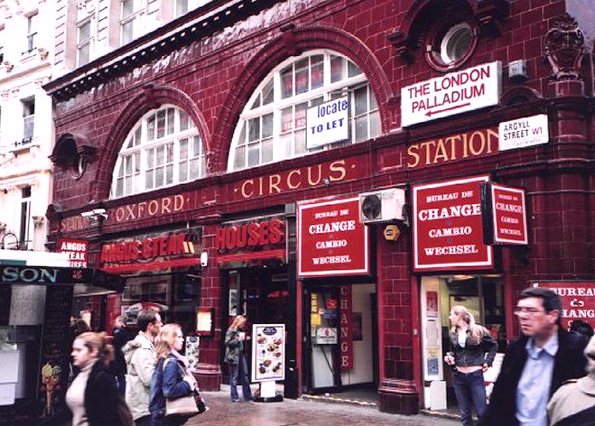 Oxford Circus station: this way for the London Palladium Oxford Circus provides an interchange between the Victoria, Bakerloo and Central and lines. A few facts about Oxford
Circus – it is one of the busiest stations on the network – certainly the
busiest, non-rail interchange, station on the tube. (85million passenger
visits in 1996). Until 1782 Oxford Street was known as Tyburn Street after
the River Tyburn that now flows underneath it. Oxford Circus was the place
to be in the 1960s – the fashion capital of the city with Carnaby Street
and Savile Row both nearby. The Beatles were frequently spotted in and
around the area and indeed their Apple headquarters – where they performed
their famous rooftop “jam” in 1969 (their last live performance) – is
along Savile Row. It seemed like a good idea to pay pilgrimage to the
Apple building and see if we could spot the famous rooftop. Alas, no sign
of Apple today and very hard to spot which roof it might have been. Maybe
some Beatles aficionados will write in and help us out… Oxford Circus - The song We toyed with the idea of
writing something about or inspired by the Beatles however this never came
to fruition. Instead we came up with a curious piece entitled “Central
line” inspired by an interesting map showing the tube lines as they would
appear if the tube map was drawn geographically accurately:
A pointless yet interesting fact about
the Central line is that although it appears to be the straightest, most
horizontal line running through London, it does in fact contain the
sharpest curve on the entire network – the so-called “caxton curve”
between Shepherds Bush and White City. The song is pitched somewhere
between John Hegley and early OMD. | ||
| Day 2... |
| Back to contents |
|
|
